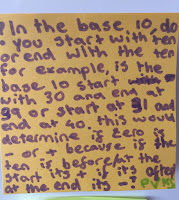Partner A says something they know about positive /negative numbers.
Partner B says something else.
They continue until a partner can't think of something else to add. When that happens, the other person has 'shot' them.
Admittedly, having kids 'shoot' each other isn't a fabulous idea, but it was a spare of the moment idea so will ask my class how can we change it next time we do this strategy.
Still, everyone was completing engaged and excitedly trying to out-do their partner.
After 5 minutes we stopped and found out who our survivors were.
I asked: What did our partners tell us that we hadn't thought about before?
Some really interesting ideas emerged.
One wondering was whether there is a connection between how / why we add and subtract pos/neg numbers the way we do and the pos/neg sides of magnets:
We discussed and played around with that idea for a bit, but felt we should add that to our wonder wall to explore further.
From that stemmed the wondering of the pos/neg side of batteries. Is there a connection with how / why we add and subtract pos/neg too?
We shared our theories of how batteries work. Which end does the energy transfer from? Why do we need to put batteries the opposite way together? Are the coils positive and that's why they match the negative side?
When we add/subtract numbers and we have +/- together we move the numbers in the negative direction? Does that idea connect with batteries too? With magnets repelling and attracting?
When we are open to student wonderings and ideas, great connections and thinking can take place.
Keeping a wonder wall of student questions is an easy and effective strategy for enquiry-based learning in maths.
After our initial unpacking of our central idea exploring positive /negative numbers (Tuning Into Our Unit), we had already generated some great wonderings to explore:
As we continue through our unit, the children are encouraged to add more for either themselves or others to explore.
Today, we looked at our wonderings and voted on which we were interested in exploring today.
We chose: Is zero positive or negative?
(Earlier in the year we had explored whether zero existed or not: Does zero exist? Kids philosophise over one of people's greatest questions )
To investigate, we used the think-pair-share routine.
After the children thought and recorded their ideas independently, they then discussed with their table partner. Some interesting debates took place as they shared their theories.
Together, they then needed to try to join their theories together and later recorded their collective ideas on a post it to share.
In sharing with the whole class, we listened to the theories and then discussed the different ideas that emerged.
Some samples:
After each, the pairs placed their note along the number line:
One student then made a wondering connection: Is it like the year zero?
We thought that was a really interesting way to try to help us solve whether zero is/is not positive /negative.
We discussed the meaning of BC / AD and BCE / CE.
Is there a year zero?
Most of us said yes and a few said no.
So we added that to our wonder wall to investigate.
Our wonder wall has grown a bit now from this:
Tomorrow, we will begin our maths learning by selecting another wondering to explore before launching into learning activities.
Enquiry-based learning has student wonderings at its core.
We need to give them proper 'air time' to give them value and because, as illustrated, children never disappoint with their creativity in thinking and the marvellous connections they come up with to enlighten others.











No comments:
Post a Comment
What do you think? ...........